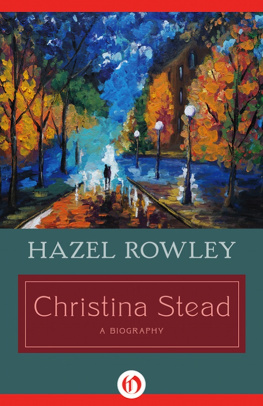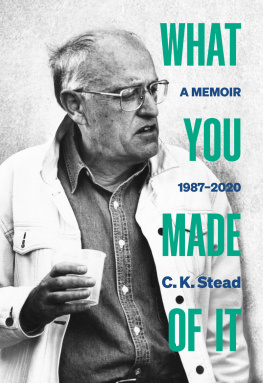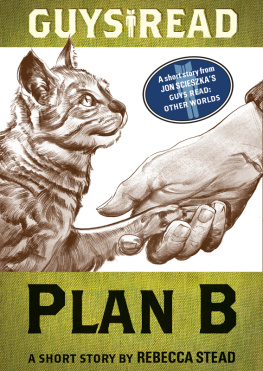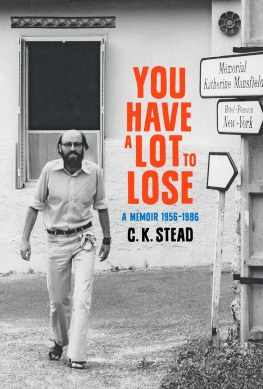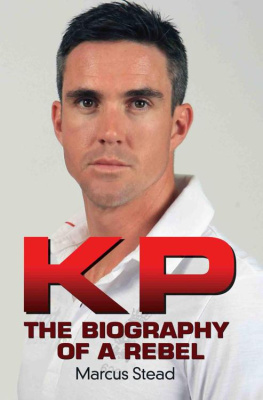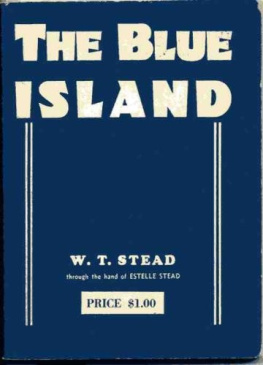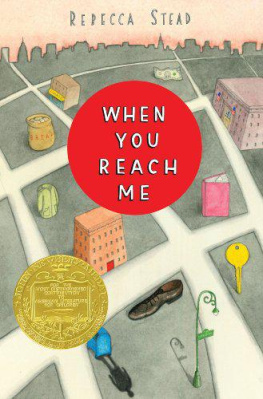
Christina Stead
A Biography
Hazel Rowley

Prologue
IT WAS THE INTERVIEWS Christina Stead gave late in life that first aroused my curiosity. Im a good-natured person, she would insist. I dont expect anything, because I dont care. I take everything as it comes. The faade she displays is brusque and pragmatic. (Most children live through great tragedies and they grow up and theyre just normal and ordinary, and its good for them.) Her rhetoric is scientificinfluenced, she would always say, by her naturalist father. (When youre a little girl and you look in an aquarium and you see fish doing this and thatyou dont criticize and say they should do something else. And thats the way in which I was brought up.)
This detached persona seems scarcely reconcilable with Steads fiction, repeatedly described by critics as savage and furious. In her two autobiographical novels, The Man Who Loved Children and For Love Alone, Steads fictional counterparts plan murder and suicide. And Stead often said she invented nothing in her fictionneither characters nor plots. I found myself wondering about the person behind the mask.
Christina Stead left Sydney as a young woman of 26; she returned aged 72, a figure of international repute, rivalling Patrick White as the finest writer Australia has produced. Though her Australian years were a wellspring from which she drew repeatedly, virtually the whole of Steads writing life46 years in allwas spent in the northern hemisphere.
No major writer of any nationality has been more truly cosmopolitan than Christina Stead, with her genius for portraying disparate locales, voices and expressions. Joyce in exile remained quintessentially Irish; D. H. Lawrence abroad, grumble as he might about his homeland, remained unmistakably English. Stead was Australian in the sense that restlessness and travel are an Australian tradition. And yet, as an Australian expatriate who set her novels in Europe, New York and the north of England, she was rejected by her compatriots as un-Australiana parochial defensiveness that endured until the late sixties.
Culturally, Christina Stead was as adaptable as a chameleon. Perhaps it is no coincidence that her generation witnessed dramatic change. She was a child of the Edwardian era and came to maturity during that period of cataclysmic change straight after the Great War, before radio and jet travel transformed communications. Like other progressives in her generation, she firmly believed that the sexual liberation of women would bring about major social transformation, and that revolutionary Russia was the worlds great hope.
She arrived in England in 1928. Wall Street crashed the following year. The movements of Stead and her companion Bill Blake would reflect those of a tide of expatriates. They were in Paris at the same time as James Joyce and Gertrude Stein, the doyens of modernism. They were in the United States when John Steinbecks The Grapes of Wrath was celebrated as the great proletarian novel. When leftwing solidarity gave way to the Second World War and its tragic aftermath, the Cold War, Stead and Blake fled McCarthyist America for Europe. But the atmosphere there had changed too: the ideals of a generation had been shattered. Steads fiction, set in three continents, expresses and takes issue with the cultural and political values of the times.
Wherever she was, Steads internal baggage went with her, but its dead weight was something she hid from others. Why does anyone want to know about the life of a writer? she once asked defensively. The writer is usually engaged in telling the story of other peoples lives.correspondence. She hated being photographed; the few photographs that exist convey a mask-like inscrutability. Her clothes, adorned as they were with frills and ruffles, were a kind of disguise, an attempt to hide her inner self. Even passages in her private diaries are written in code.
Stead would sometimes say that she had no need to write an autobiography; she had already written it in her books. But her fiction is transmuted reality. Her obvious alter egos, Louisa, Teresa, Lydia, Persia, Lauraall with names ending in a, like Christinaare idealised Christinas. None of them are hanging in Steads notorious gallery of fictional monsters. Those all have other models, but just like Victor Frankensteins creation, Steads monsters partly represent her own shadow side.
Nabokov once commented: Literature is invention. Fiction is fiction. To call a story a true story is an insult to both art and truth. Every great writer is a great deceiver.
A biography is not a life; lives cannot be recovered. No one knew better than Stead that life itself is a narrative. We are continually revising our memories and hopes, rationalising disappointments, modifying the way we present ourselves to ourselves and others. Everything we do has a hidden aspect; every incident has several versions; each moment of our lives is invisibly shaped by our unpruned, tangled past.
Turning life into story is one of humanitys enduring pleasures. Stead may not even have been aware of the paradox when she wrote: The true portrait of a person should be built up as a painter builds it, with hints from everyone, brush-strokes, thousands of little touches.
1 Ocean of Story
July 1902August 1917
IN CHRISTINA STEADS MEMORY, her mother was a dim vision of pale skin, dark eyes, and long dark hair lying across a pillow on a high brass and lacquer bed.
Filled with a sense of betrayal, the child left the room. She was fingering the panelling of the door, not knowing why she had been sent out, when her aunt came along: What are you doing therespying? Although she was only 21/2, the child knew what was meant. Her aunt shooed her away. Seventy-seven years later, Christina Stead was still angry.
But had she imagined it all? Later, the sick young woman became blurred in Steads mind with Emma Bovary on her deathbed, where she too was visited by a frightened small daughter. Did Stead really recall Sydney in the summer of 1904? Or was that darkened room actually in Yonville-LAbbaye, a provincial town in Normandy?
Christina Stead never made much consciously of the loss of her mother, though she did once say, comparing herself to a guttercat, that she had not trusted anyone since she was about 2.
After her mothers death, she became her fathers special girl. My mother diedhe mothered me. David George Stead was a lively young scientist, a zoologist, brimming with stories about the marvels of the natural world and its strange inhabitants. In the evenings, with the light falling from the streetlamp through the open slats of the Venetian blind and his foot on the packing-case on which his daughter slept, he would tell his tales. And it went on and on, night after night, for more than two years.
Among the last things Stead wrote were two tender pieces reconciling her to the unusually gifted man whom she had reviled in her most famous novel, The Man Who Loved Children. It was her father, she acknowledged, who had taught her to swim in the ocean of story.
Christina Ellen Stead was third-generation Australian. She liked to think her family history was shaped by literature. In Great Expectations, published in 1861, the convict Magwitch is transported to Australia, where he makes his fortune in sheep. In 1862, Steads paternal grandfather (an avid reader of Dickens) packed his bags, farewelled his family in Kent and boarded the
Next page
